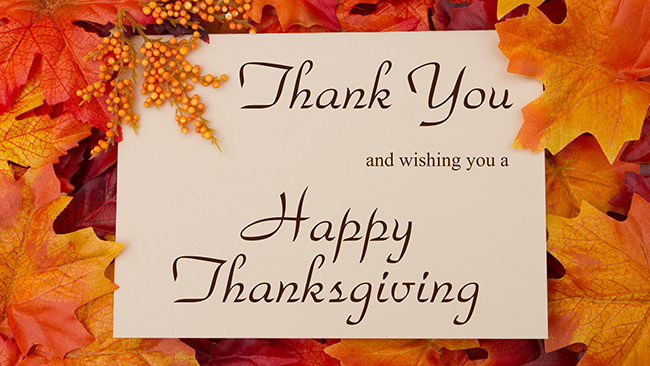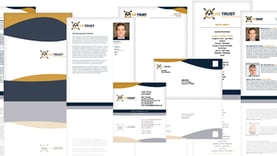When do you receive the most cards? I’m going to take a wild guess that it’s in December during Christmas season (or Hanukkah, Kwanzaa, Winter Solstice, Las Posadas, or Festivus).

Which is exactly why you can’t just send a Christmas card during the holiday hustle and bustle and expect to get noticed. Talk about throwing a needle into a haystack! Thankfully, there's something else you can do to stand out and build more effective client relationships this holiday season...
There are a few marketing reasons to change up your normal Christmas-card-sending routine that can be applied to other areas of your business as well. And I’ll get to that shortly, so stick with me.
Instead of focusing solely on sending a Christmas card…
there’s a little holiday that often gets trampled in the mad dash from scary costumes to the mayhem we call Black Friday.This window of opportunity is the perfect time to make a meaningful impact on your clients AND let them know how thankful you are for their business.
Check this out: Every Thanksgiving, one of our top producers sends a thank you card along with a gift card to the client’s local pie shop. Why is this a smart approach?
First, it shows he’s on the ball because he remembered to send out a Thanksgiving card.
Secondly, it takes some initiative to find the location closest to the client and then on top of that, go out and buy the gift card. Not to mention the monetary aspect of it (minimal, but not inconsequential).
The added effort you put in, SHOWS clients what you could spend all year trying to TELL them. That’s the problem with a lot of service providers — all talk, no action.
But not you, after reading this you’ll get a jump on the competition and let the client know how much you appreciate their business before they start to deck the halls.
And that’s something they’re apt to tell others about and become your ‘brand ambassador,’ if you will.
More than a card
This simple expression of gratitude is also part of a bigger business lesson —
You can choose to do what everyone else does: go through the motions, send your requisite Christmas card OR you can differentiate yourself by finding little ways to do the unexpected.
In a world where everyone is trying to one-up each other to get seen, trying to “best” your competition, can get crazy. Take this totally unrelated example — ab workout programs. First, it was ‘get fit’ then ‘get fit in 30 minutes’ to ‘leaner abs in 15 min, in 10, in 8… what’s next? 2 minutes?”
See what I mean? Crazy.
And in our industry, it’s the same thing — it’s getting more and more difficult to “beat the competition,” if all we focus on is trying to be so-called “better.”
Even if we aren’t trying to one-up each other, we can fall into this trap of being so much alike that clients and prospects have no idea why they should choose one person or business over the next…
That’s why doing something different is so important.
Because when you’re different (Read: interesting, creative, memorable) …
That makes people sit up and take notice.
Why "different" is the new "better"
Because the element of surprise is like a “pattern interrupt.” You may be familiar with this term, there’s the neuro-linguistic programming (NLP) version and then there’s the Sandler Sales Methodology version, but the point of both is to break from normal routine to get a reaction.
Doing something unexpected can help tap into people’s emotions. If you can get a client to say — “Wow!” And if you can get them to feel genuinely special, then you’re on to something. Considering the holidays can be a very lonely time for many people, a “You’re important to me” message may be just what your client needs in that moment.

This is emotional marketing
Emotional marketing is a real thing. And even though sending a card may not be explicitly marketing, it can help create loyal and enthusiastic clients because it accesses those core psychological drivers like:
· Safety
· Belonging
· Status
· Happiness
Pretty sure you’ve heard this one:
“I’ve learned that people will forget what you said, people will forget what you did, but people will never forget how you made them feel.” – Maya Angelou
Let's put a bow on it...
It’s not that far-reaching to believe that a simple card could promote good feelings beyond those felt in the moment they receive it.
That’s what we call the halo effect.
From whatis.com: “The halo effect is a form of cognitive bias which causes one part to make the whole seem more attractive or desirable. This concept can be applied to people, products, brands and companies. Confirmation bias can strengthen the halo effect. Once a positive opinion of a person or product has been formed, positive interactions with that person or product are seen to reinforce that favorable opinion, but negative interactions are often disregarded.”
The best way to serve our clients and build on any positivity we’ve created, is to provide the level of service that warrants it.
It’s about more than a feel-good card, it’s about showing our clients we’re the type of professionals who care, who solve problems, and inspire hope. It lets our clients and prospects know we appreciate them.
If we can do all that by simply sending a Thanksgiving card — that’s definitely an opportunity to be grateful for.
If you liked this post, please share it or, better yet, subscribe to our blog by entering your name and email on this page.





